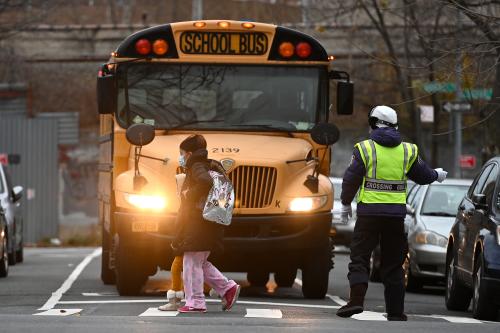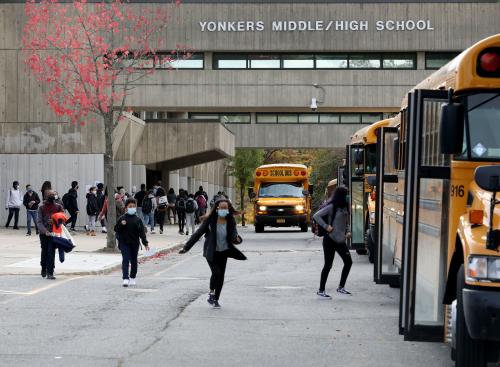It’s not every week that public schools feature prominently in a White House press briefing, a prime-time town hall with the president, and a “Today” show interview with the vice president. We’re seeing the politics of education take the national stage at a time when Americans’ eyes are trained on the new presidential administration.
There is, of course, good reason for schools to be in the news. Many American students haven’t stepped inside of a classroom in almost a year. The impacts of COVID-19 disruptions on students, educators, parents, and school systems are vast, in no small part because of the prior administration’s mismanagement of the pandemic. Now, we’re looking to a new administration for a better sense of how the rest of this school year and beginning of next year might look.
In this environment, early missteps from the White House on school reopenings are attracting attention. That includes a clumsy explanation of its reopening target after President Biden’s first 100 days and the confusing rollout of new CDC guidance. The attention has focused as much on education politics as policy, with questions about why the new administration is struggling with communications about school reopenings, whether they set an unambitious target for reopenings, and who is influencing their decisions.
Despite this attention, a few important points might be getting lost in the shuffle.
1. The problem with the administration’s reopening targets is more fundamental than just sloppy communication.
The administration’s stated goal, broadly defined, is that most elementary and middle schools will be open for in-person learning in Biden’s first 100 days in office. The exact definition has been elusive, as the definition of “open” has seemed to shift.
The bigger problem, though, is that this was always the wrong type of goal. The school reopening target is different from, say, the administration’s target of administering 100 million vaccine doses in 100 days. With vaccines, more is better. With school reopenings, there’s ambiguity. We should want in-person schooling everywhere that it’s safe to do so—and only those places. If 100% of schools can open safely, it’s inexcusable for just half of them to open; if only 25% can open safely, it’s inexcusable to have twice that number open.
A more appropriate goal for reopening—albeit less measurable—would be that every school is “as open” as it can be safely, or that every school complies with the CDC’s guidance. With COVID-19 rates declining and vaccines becoming more widely available, hopefully that will mean near-universal openings soon.
2. The new CDC guidance should help make reopenings less partisan, even if they’ve attracted their share of criticism.
The CDC’s new guidelines for school reopenings met widespread, wide-ranging criticism. Some criticized the guidelines for being “old news”—that they look like the Trump administration’s guidance or recommend mitigation measures already in place in many schools. Many criticized the rollout—that a 35-page PDF report needed simpler accompanying resources. Others called the guidelines either too stringent or not stringent enough.
Without a background in epidemiology, I can’t speak to whether the guidelines (or thresholds) are appropriately stringent. On the politics, though, the topic of school reopenings has been so partisan that it’s likely muddled decision-making for both policymakers and parents. At least in this respect, it’ll help that these guidelines—and the underlying goal of getting students back in schools—are broadly consistent with those from the prior administration.
3. The conversation about teachers’ unions and their influence on the Biden administration tells only half of the story.
There is no doubt that teachers’ unions are influential in education. Their financial resources and capacity for mobilizing volunteers are unparalleled, and, at minimum, they seem to have a seat at the table in the Biden administration. But this is a two-way street. While the Biden administration may feel pressure to align itself with teachers’ union priorities, union leadership likely feels at least that much pressure to align itself with the administration’s priorities.
Unions are in a precarious spot politically. They’re enmeshed in conflicts across the country, and state and local affiliates aren’t all on the same page about what’s required for in-person reopening. Support for unions has held up in polls so far, but that could change if the public comes to believe that teachers aren’t holding up their end of the bargain by resisting in-person schooling even after getting near the front of vaccine lines.
Teachers’ unions have long been a favorite target of Republicans, and that’s intensified in recent months. The last thing that PR-savvy unions want is to be an island, apart from the Biden administration, too. When union leaders publicly side with Biden’s position on controversial issues—as Randi Weingarten did on school reopenings—it doesn’t necessarily mean that the administration followed the unions’ lead (a common accusation in conservative media). It could mean just the opposite. Or, of course, it could be that the administration and unions happen to agree.
4. Most importantly, the Biden administration has an extraordinary opportunity to make long-term improvements to public education—but it won’t last long.
The immediate focus in education policy is about school reopenings and attending to the harm done by school disruptions. That makes sense. But we should remember what an unusual—and fleeting—opportunity the Biden administration (and Congress) has to make a lasting, positive impact through increased federal investment.
Education rarely has a focusing event that commands the country’s attention and creates a window for policymaking. The pandemic is a focusing event for education (educational inequity, in particular), as it’s exposed and exacerbated long-lasting problems in the U.S. education system. Many proposed responses to the pandemic—more funding for high-poverty schools, a large-scale tutoring initiative, universal broadband, facilities upgrades to reduce children’s exposure to contaminants—are the same types of federal actions that could address those long-lasting issues. Importantly, these are primarily matters of federal investment, not management—which tend to be messier and more controversial. And this is a time when attitudes toward federal spending are changing, and Democrats have unified control in Washington.
It’s a remarkable confluence of events that gives the Biden administration a window of opportunity to invest in the country’s education system in ways that haven’t been available to prior administrations. However, that window won’t stay open long, with the next election (and crisis) always around the corner.






Commentary
A crash course in education politics for the Biden administration
February 19, 2021